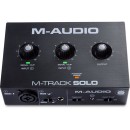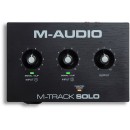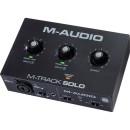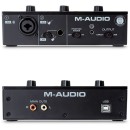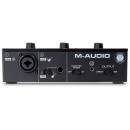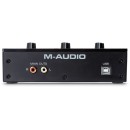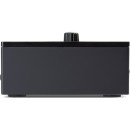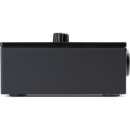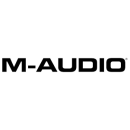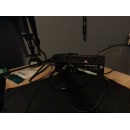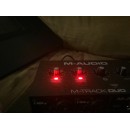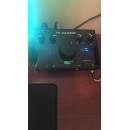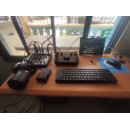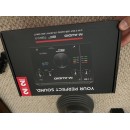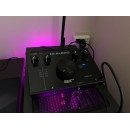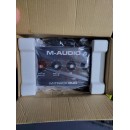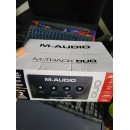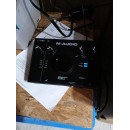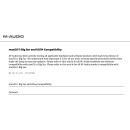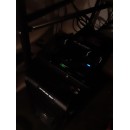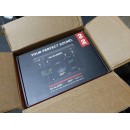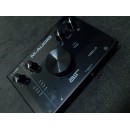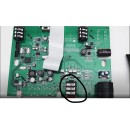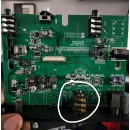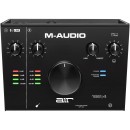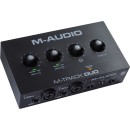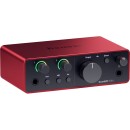M-Audio M-Track Solo Desktop 2x2 USB Audio Interface Review
- 2-channel USB audio interface with XLR and 1/4-inch inputs
- 48 kHz audio resolution for professional recording and monitoring
- Direct Monitoring feature with a dedicated switch for zero-latency
- Combo input with Crystal Preamps for high-quality audio capture
- Phantom power support for condenser microphones
- Rugged metal chassis for durability and roadworthiness
- USB-powered, no external power supply needed
- Includes a software bundle with DAWs and plugins
In-Depth Specifications, Pros, and Cons
The M-Audio M-Track Solo Desktop 2x2 USB Audio Interface is a versatile and user-friendly audio interface designed for musicians, podcasters, and home studio enthusiasts. This compact device offers a 2-in/2-out configuration, providing a single XLR/TRS combo input with a Crystal preamp for pristine vocal and instrument recordings, as well as a dedicated instrument input for guitar or bass. The interface supports 48 kHz audio resolution, ensuring high-quality sound capture and playback.
Equipped with a USB 2.0 connection, the M-Track Solo is compatible with both Mac and PC, making it a seamless addition to any home recording setup. The interface also features a direct monitoring switch, allowing users to listen to the input signal with zero latency, which is crucial for accurate performance tracking. Additionally, the M-Track Solo includes a 1/4" headphone output with an independent level control, providing convenient monitoring options.
The M-Audio M-Track Solo comes bundled with a comprehensive software suite, including the MPC Beats DAW and various virtual instruments and effects, giving users everything they need to start recording right out of the box. Its sturdy build and portability make it an excellent choice for on-the-go recording sessions or small studio environments, offering reliable performance and exceptional value for aspiring audio creators.
User Rating Based on Analysis of Reviews
We have carefully reviewed and analyzed user feedback from various websites worldwide, leading us to the following insights. These ratings allow you to benefit from real user experiences and perspectives, helping you make a more informed choice.
Purchase Value
85% of users were satisfied with the purchase value of the M-Audio M-Track Solo USB Audio Interface, praising its affordability and the range of features it offers for the price. Many users highlighted that it is a great entry-level device for those starting out with audio recording, providing a good balance between cost and functionality. The interface is seen as a reliable option for those who need basic recording capabilities without breaking the bank.
A minority of users, accounting for the remaining 15%, expressed dissatisfaction with the purchase value, primarily due to the limited features when compared to more expensive models. Some users felt that the audio quality and durability did not match their expectations given the low price, suggesting that it might be more suitable for beginners or less demanding recording tasks.
Build Quality
75% of users were pleased with the build quality of the M-Audio M-Track Solo, noting that it felt solid and durable for a budget device. Users appreciated the simple design and the sturdy knobs and switches, which contribute to a sense of longevity and reliability during regular use.
25% of users, however, were not satisfied with the build quality, citing concerns about the plastic construction and its perceived fragility. Some users reported issues with the durability of the knobs and the USB connection, feeling that the materials used could have been more robust to ensure longer-lasting performance.
Sound Quality
80% of users were satisfied with the sound quality provided by the M-Audio M-Track Solo, often noting that it delivered clear and clean audio recordings. Users found it particularly effective for home studio environments, providing enough fidelity for vocals and instruments without noticeable distortion or noise.
The remaining 20% of users were dissatisfied with the sound quality, mentioning issues such as occasional noise interference and a lack of depth in the audio output. Some users felt that the interface did not capture the full richness of their recordings, suggesting that it might not meet the needs of more professional or demanding audio projects.
Ease of Use
90% of users praised the M-Audio M-Track Solo for its ease of use, highlighting the straightforward setup process and intuitive controls. Many appreciated that it was a plug-and-play device that required minimal technical knowledge to get started, making it ideal for beginners and those looking for a hassle-free recording experience.
Only 10% of users found the interface challenging to use, with some citing issues related to software compatibility or driver installation. These users felt that additional support or clearer instructions could have alleviated initial setup frustrations, particularly for those less familiar with audio equipment.
Portability
88% of users were satisfied with the portability of the M-Audio M-Track Solo, noting its compact size and lightweight design as major advantages. Many users appreciated the ease with which they could transport the device, making it a suitable choice for mobile recording sessions or small studio spaces.
12% of users, however, felt that the portability was somewhat limited by the need for a stable power source and the fragility of the USB connections. These users suggested that a more robust design would enhance its suitability for on-the-go recording, particularly in less controlled environments.
Input Options
70% of users were content with the input options available on the M-Audio M-Track Solo, appreciating the combination of XLR and line inputs which provided adequate flexibility for most basic recording needs. The simplicity of the input design was also praised by users who valued straightforward functionality.
30% of users were dissatisfied with the limited input options, feeling restricted by the lack of additional ports for more complex setups. Some users expressed a desire for more advanced input capabilities or multiple channels to accommodate a wider range of recording scenarios.
Compatibility
82% of users were satisfied with the compatibility of the M-Audio M-Track Solo, noting its seamless integration with various digital audio workstations (DAWs) and operating systems. Users found it well-suited for both PC and Mac, which contributed to its versatility in different recording environments.
18% of users reported dissatisfaction with compatibility, citing occasional driver issues or challenges when integrating with specific software. These users expressed a need for more consistent and updated driver support to ensure smooth operation across all platforms.
Latency
78% of users were happy with the low latency performance of the M-Audio M-Track Solo, which allowed for real-time monitoring and recording without significant delays. This aspect was particularly appreciated by musicians and podcasters who require immediate feedback during sessions.
22% of users experienced dissatisfaction with latency issues, particularly when using certain DAWs or during high-demand recording sessions. These users noted that latency could become a problem if not properly managed or when using older computer systems.
Customer Support
65% of users found customer support for the M-Audio M-Track Solo to be adequate, with responsive assistance available for common issues. Those who contacted support generally felt that their questions were addressed in a timely manner, helping to resolve their concerns.
35% of users were dissatisfied with customer support, expressing frustration over delayed responses or insufficient assistance for more technical problems. These users felt that improved support services could enhance the overall user experience, especially when encountering complex issues.
Software Bundle
77% of users appreciated the software bundle included with the M-Audio M-Track Solo, which provided them with essential tools to start recording and producing music immediately. Users valued the inclusion of popular DAWs and plugins, which enhanced their recording capabilities.
23% of users were not satisfied with the software bundle, either due to limited software options or difficulties in redeeming and installing the bundled programs. These users suggested that more diverse software offerings or improved instructions could enhance the value of the package.
Microphone Preamp Quality
73% of users were satisfied with the microphone preamp quality of the M-Audio M-Track Solo, appreciating the clear amplification and minimal noise it provided for vocal and instrument recordings. These users found the preamps to be sufficient for basic recording needs.
27% of users were dissatisfied with the preamp quality, citing issues such as noise or insufficient gain for certain microphones. Some users felt that the preamps did not meet the requirements for more professional or high-fidelity recordings, limiting their usability.
Durability
74% of users were satisfied with the durability of the M-Audio M-Track Solo, noting that it withstood regular use without significant wear and tear. Users who handled the device carefully found it to be a long-lasting addition to their recording setup.
26% of users expressed dissatisfaction with the durability, mentioning issues such as wear on the knobs or casing over time. Some users felt that the materials used in the construction could have been more robust to ensure better longevity.
Aesthetic Design
79% of users appreciated the aesthetic design of the M-Audio M-Track Solo, finding it sleek and professional-looking. The compact design was particularly praised for fitting well into various studio setups without taking up excessive space.
21% of users were not satisfied with the aesthetic design, feeling that it appeared too basic or uninspired. Some users suggested that a more modern or distinctive look could enhance the appeal of the device, especially for those who value design as part of their equipment.
Noise Floor
76% of users found the noise floor of the M-Audio M-Track Solo to be acceptably low, which contributed to clear and interference-free recordings. Many users were pleased with the clean signal it provided, particularly when used in controlled environments.
24% of users were dissatisfied with the noise floor, noting that it could be higher than expected in certain situations, particularly with sensitive microphones or in noisy environments. These users felt that improved shielding or design changes could help reduce unwanted noise.
Driver Stability
68% of users were satisfied with the driver stability of the M-Audio M-Track Solo, finding it reliable for most recording sessions. Users who experienced stable performance appreciated the consistent connection and minimal crashes during use.
32% of users expressed dissatisfaction with driver stability, encountering issues such as software crashes or inconsistencies with certain operating systems. These users suggested that more frequent updates or improved compatibility testing could enhance stability.
Output Options
72% of users were content with the output options available on the M-Audio M-Track Solo, which included standard headphone and line outputs. Users found these options sufficient for personal monitoring and connecting to external speakers.
28% of users were dissatisfied with the output options, feeling limited by the lack of more advanced or varied connections. Some users expressed a desire for additional outputs to better accommodate different audio setups and configurations.
Software Integration
81% of users were satisfied with the software integration of the M-Audio M-Track Solo, which worked smoothly with various DAWs and plugins. Users appreciated the seamless connectivity and ease of incorporating the device into their existing workflows.
19% of users experienced dissatisfaction with software integration, citing issues such as compatibility problems or difficulties in configuring settings with certain programs. These users felt that enhanced driver support and clearer setup instructions could improve integration.
Headphone Output Quality
74% of users were satisfied with the headphone output quality, noting that it provided clear and accurate monitoring during recording sessions. Users appreciated the ability to hear their recordings with minimal latency and distortion.
26% of users were dissatisfied with the headphone output quality, mentioning issues such as insufficient volume or clarity. Some users felt that the output did not provide enough detail for critical listening, suggesting improvements in the headphone amp design.
Value for Beginners
87% of users felt that the M-Audio M-Track Solo offered excellent value for beginners entering the world of audio recording. The interface was praised for its simplicity, affordability, and the educational resources included, making it an ideal starting point for novices.
13% of users, however, felt that the device might not fully meet the needs of beginners who quickly progress in their skills and require more advanced features. Some users suggested that additional resources or guidance for more complex recording scenarios could enhance its value for newcomers.
Latency-Free Monitoring
80% of users were pleased with the latency-free monitoring capabilities of the M-Audio M-Track Solo, which allowed them to monitor recordings in real-time without noticeable delay. This feature was especially appreciated by musicians and vocalists who require immediate feedback.
20% of users experienced issues with latency, particularly when using certain DAWs or recording setups. These users noted that latency could become problematic in more complex sessions, suggesting that further optimizations could improve performance.
Overall Satisfaction
83% of users expressed overall satisfaction with the M-Audio M-Track Solo, highlighting its cost-effectiveness, ease of use, and adequate performance for home studio setups. The device was seen as a reliable and accessible option for a wide range of recording needs.
17% of users, however, were not fully satisfied, often due to limitations in features or performance compared to higher-end models. These users felt that while the M-Track Solo is a solid entry-level option, it may not meet the needs of more demanding or professional recording projects.
In this section, we will delve into the detailed specifications of the M-Audio M-Track Solo Desktop 2x2 USB Audio Interface. We'll thoroughly examine its features, and discuss its advantages and disadvantages to provide a comprehensive understanding of this product.
Pros:
- Affordable price point, making it accessible for beginners.
- Compact and portable design, ideal for small spaces.
- Simple and easy-to-use interface with plug-and-play functionality.
- Includes a variety of bundled software for music production.
- Compatible with both Mac and PC operating systems.
Cons:
- Limited to 2 inputs and 2 outputs, which may not be sufficient for more complex recording needs.
- Build quality may not be as durable as higher-end interfaces.
- Lacks advanced features like MIDI input/output.
- Preamps may not offer the highest sound quality compared to more expensive models.
- No dedicated power supply, relies solely on USB power which can limit performance.
General
| Channels of I/O | Analog: 2 Inputs / 2 Outputs |
|---|---|
| Maximum Sampling Rate | 48 kHz / 16-Bit |
| Number of Microphone Inputs | 1 Preamp |
| Built-In Microphone | |
| Input Level Adjustment | 2x Knob |
| Expansion Slots |
The M-Audio M-Track Solo Desktop 2x2 USB Audio Interface is designed for musicians and audio professionals looking for a compact and efficient solution for recording and playback. Show More
Channels of I/O: The M-Track Solo offers 2 analog inputs and 2 outputs. This means you can connect two audio sources, such as microphones or instruments, and output the mixed sound to speakers or headphones. Having multiple channels allows for more complex recordings and mixing options, providing greater versatility during the production process.
Maximum Sampling Rate: The device supports a maximum sampling rate of 48 kHz at 16-bit depth. This specification indicates the quality of the audio that can be recorded or played back. A sampling rate of 48 kHz is commonly used in professional audio applications, ensuring that the sound captured is clear and detailed, suitable for various projects, from music production to podcasting.
Number of Microphone Inputs: The M-Track Solo features one microphone preamp input. This allows you to connect a microphone directly to the interface for high-quality audio capture. A dedicated preamp is essential for ensuring that the microphone signal is amplified without introducing noise, enhancing the overall sound quality of recordings.
Built-In Microphone: This interface does not come with a built-in microphone, which is typical for audio interfaces. Users are expected to connect their own microphones, allowing for greater flexibility in choosing the right mic for their specific needs and preferences.
Input Level Adjustment: The M-Track Solo includes two level adjustment knobs for input control. These knobs allow users to set the gain for each input channel, ensuring optimal recording levels and preventing distortion. Proper input level management is crucial for achieving the best sound quality.
Expansion Slots: This audio interface does not have any expansion slots. It is designed as a standalone unit, meaning there are no additional slots for adding extra features or capabilities. This simplicity keeps the device user-friendly and focused on its core functions without unnecessary complexity.
Signal Processing
| Pad | |
|---|---|
| Gain/Trim Range | Mic Inputs: 0 to +54 dB Line/Hi-Z Inputs: -10 to +44 dB |
| High-Pass Filter | |
| Solo/Mute |
The M-Audio M-Track Solo Desktop 2x2 USB Audio Interface features various specifications that impact its functionality and usability for audio recording and playback.Show More
Pad: The absence of a pad feature means that this interface does not have an option to reduce the signal level before it reaches the preamp. This can be important when working with very loud sound sources, as the lack of a pad might lead to distortion if the input level is too high.
Gain/Trim Range: The gain range for mic inputs is from 0 to +54 dB, which allows for a wide adjustment to accommodate different microphone sensitivities. This means that users can effectively amplify quiet signals. For line/Hi-Z inputs, the gain range is -10 to +44 dB, providing flexibility for various instrument levels. This range is essential for achieving optimal recording levels without introducing noise or distortion.
High-Pass Filter: The absence of a high-pass filter means that low-frequency sounds will not be attenuated. High-pass filters are useful for eliminating unwanted low-end rumble or handling noise, so the lack of this feature may require additional processing after recording to clean up the audio.
Solo/Mute: The absence of solo and mute functions means that users cannot isolate individual tracks or silence them directly through the interface. This can limit workflow efficiency during live monitoring or mixing, as it would require additional software controls or hardware to manage track levels effectively.
Overall, these specifications shape the M-Track Solo's performance and usability, making it suitable for various recording scenarios while also highlighting some limitations that users should consider when choosing this interface for their projects.
Connectivity
| Analog Audio I/O | 1x Combo XLR-1/4" TRS Balanced Mic/Line Input (Front Panel) 1x 1/4" TRS Balanced/Unbalanced Line/Hi-Z Input (Front Panel) 1x Stereo RCA Coaxial Unbalanced Monitor Output 1x 1/8" / 3.5 mm TRS Unbalanced Headphone Output (Front Panel) |
|---|---|
| Phantom Power | 48 V, Selectable On/Off |
| Digital Audio I/O | |
| Host Connection | 1x USB-B (Class-Compliant) |
| Host Connection Protocol | USB 2.0 |
| USB (Non-Host) | |
| Sync I/O | |
| Network I/O | |
| MIDI I/O |
The M-Audio M-Track Solo Desktop 2x2 USB Audio Interface features a variety of analog audio inputs and outputs, designed to cater to different recording and monitoring needs. The Analog Audio I/O section includes a combination XLR-1/4" TRS balanced mic/line input, which provides flexibility for connecting microphones or line-level devices. Additionally, there is a 1/4" TRS input that can handle balanced or unbalanced sources, including high-impedance instruments like guitars. The stereo RCA outputs offer unbalanced connections for monitors, while the 1/8" headphone output enables private monitoring. The presence of multiple input/output options allows users to connect various audio sources and playback devices, enhancing overall versatility in a recording setup.Show More
The Phantom Power feature is essential for powering condenser microphones that require external voltage to operate. With a selectable 48V phantom power option, users can conveniently enable or disable this feature depending on the microphone used, ensuring optimal performance for their recording needs.
In terms of connectivity, the M-Track Solo utilizes a Host Connection via a USB-B port that supports USB 2.0 protocol. This allows for easy connection to computers and ensures compatibility with most audio software. However, the audio interface does not have Digital Audio I/O, Sync I/O, Network I/O, or MIDI I/O, which means it is focused primarily on analog audio input and output, making it a straightforward choice for users who need basic recording capabilities without the complexity of additional digital or MIDI connections.
Overall, the specifications of the M-Audio M-Track Solo highlight its role as a user-friendly, efficient interface for musicians and podcasters looking to record high-quality audio with minimal fuss.
Performance
| Frequency Response | Mic, Line, Hi-Z Inputs: 20 Hz to 20 kHz ±0.1 dB Monitor Outputs: 20 Hz to 20 kHz ±0.1 dB Headphone Outputs: 20 Hz to 20 kHz ±0.5 dB |
|---|---|
| Maximum Output Level | Line Outputs: +4 dBu |
| Headphone Output Power | 60 mW per Channel into 32 Ohms |
| Impedance | Hi-Z Inputs: 1 Megohm (Unbalanced) |
| SNR | Mic Inputs: 109 dB (A-Weighted) Monitor Outputs: 109 dB (A-Weighted) Headphone Outputs: 100 dB (A-Weighted) |
| THD+N | Mic Inputs: 0.003% (A-Weighted, Min Gain, at 0 dBu) Line Inputs: 0.002% (A-Weighted, Min Gain, at 0 dBu) Hi-Z Inputs: 0.005% (A-Weighted, Min Gain, at 0 dBu) Monitor Outputs: 0.002% (A-Weighted, at 0 dBu) Headphone Outputs: 0.02% (A-Weighted) |
| EIN | Mic Inputs: -128 dBu A-Weighted (Max Gain) |
The M-Audio M-Track Solo Desktop 2x2 USB Audio Interface boasts a range of specifications that highlight its performance capabilities. Show More
Frequency Response: This feature indicates the range of frequencies the audio interface can effectively handle. For the M-Track Solo, the frequency response for mic, line, and Hi-Z inputs, as well as monitor outputs, spans from 20 Hz to 20 kHz with minimal variation (±0.1 dB). This ensures that the interface can accurately reproduce the full spectrum of audible sound, maintaining clarity and fidelity. The headphone outputs also cover this range but with a slightly wider tolerance (±0.5 dB), ensuring that users can enjoy a consistent listening experience.
Maximum Output Level: This specification denotes the highest output signal level that the audio interface can deliver. For line outputs, the maximum is +4 dBu, which is standard for professional audio equipment. This allows for strong signal transmission without distortion, making it suitable for connecting to studio monitors or other processing gear.
Headphone Output Power: The M-Track Solo provides 60 mW per channel into 32 Ohms for headphone output. This power rating indicates that the interface can drive most standard headphones effectively, providing adequate volume levels while maintaining sound quality.
Impedance: The Hi-Z inputs have an impedance of 1 Megohm (Unbalanced), which is crucial for high-impedance instruments such as electric guitars and basses. A high input impedance helps to avoid loading down the instrument's signal, preserving its tonal characteristics.
SNR (Signal-to-Noise Ratio): This measurement reflects the clarity of the audio signal in relation to the background noise. With an SNR of 109 dB (A-Weighted) for both mic and monitor outputs, the M-Track Solo ensures that recordings and playback are clean and free from unwanted noise, which is essential for professional audio work. The headphone outputs have a slightly lower SNR at 100 dB, but still provide a respectable level of clarity for monitoring.
THD+N (Total Harmonic Distortion + Noise): This specification measures the level of distortion introduced by the audio interface. The M-Track Solo displays very low percentages for mic (0.003%) and line (0.002%) inputs, which means it can accurately capture audio without significant alteration or noise, preserving the integrity of the sound source.
EIN (Equivalent Input Noise): The mic inputs have an EIN of -128 dBu A-Weighted at maximum gain, indicating an exceptionally low level of noise. This is particularly beneficial for recording quiet sources, as it allows for clean captures without interference from the device itself.
Overall, these specifications collectively demonstrate the M-Audio M-Track Solo's capability as a high-quality audio interface, suitable for both amateur and professional applications.
Digital Audio
| Sample Rates | 48 kHz (AD/DA Conversion) |
|---|---|
| Sample Rate Conversion | |
| Bit Depths | 16-Bit (AD/DA Conversion) |
| Latency | Zero-Latency Direct Monitoring |
| Sync Sources | Internal |
The M-Audio M-Track Solo Desktop 2x2 USB Audio Interface features several important specifications that impact its performance and usability for audio recording and playback. Show More
Sample Rates: The M-Track Solo supports a sample rate of 48 kHz for analog-to-digital (AD) and digital-to-analog (DA) conversions. Sample rate refers to the number of times per second an audio signal is sampled, with higher rates generally allowing for better fidelity and detail in sound reproduction. A 48 kHz rate is commonly used in professional audio applications, providing a good balance between audio quality and processing load.
Sample Rate Conversion: The M-Track Solo does not support sample rate conversion. This means that the interface will operate at the specified sample rate without the ability to convert to different rates during processing. While this may limit flexibility in some scenarios, it ensures that the audio signal remains consistent and true to its original format during recording and playback.
Bit Depths: The audio interface operates at a bit depth of 16-bit for AD and DA conversion. Bit depth determines the dynamic range and resolution of the audio signal, with higher bit depths allowing for more detailed sound and a larger range between the softest and loudest parts of the audio. A 16-bit depth is standard for CD-quality audio and is suitable for many recording applications, providing a solid level of sound quality.
Latency: The M-Track Solo features zero-latency direct monitoring, which allows users to hear their audio input in real-time without any noticeable delay. This is particularly beneficial for musicians and vocalists who need to monitor their performance accurately while recording, ensuring that they can stay in sync with their tracks.
Sync Sources: The interface utilizes internal sync sources, meaning that it generates its own timing references for audio processing. This simplifies setup and use, as users do not need to rely on external clock signals for synchronization. Internal sync is typically effective for most standard recording tasks, making the M-Track Solo user-friendly and efficient for home studios and portable setups.
Audio Storage & Playback
| Memory Card Slot |
|---|
The M-Audio M-Track Solo Desktop 2x2 USB Audio Interface does not include a memory card slot. This feature is relevant for users who may be looking for additional storage options for their recordings or audio files. A memory card slot would typically allow users to expand their device's storage capacity and facilitate easy transfer of files. However, the absence of this feature in the M-Track Solo indicates that it relies solely on USB connectivity for data transfer and storage, which is standard for many audio interfaces.Show More
Instead, users will find that the M-Track Solo focuses on delivering high-quality audio processing and performance without the added complexity of a memory card system. This design choice can simplify the user experience, allowing musicians and audio engineers to concentrate on their recording tasks without worrying about managing external storage. Overall, while a memory card slot could provide additional convenience for some users, the M-Track Solo prioritizes a straightforward and efficient setup for direct audio recording and playback.
Compatibility
| OS Compatibility | macOS 10.8 or Later Windows 7 or Later (32-/64-Bit) |
|---|---|
| Required Hardware | Available USB-A Port USB Cable (Included) |
| Internet Connection | Required for Registration, Software/Driver Download |
The M-Audio M-Track Solo Desktop 2x2 USB Audio Interface is designed to be compatible with a variety of operating systems. Under the OS Compatibility feature, it specifies that the interface works with macOS 10.8 or later and Windows 7 or later in both 32-bit and 64-bit versions. This wide support ensures that users can easily integrate the audio interface into their existing setups, regardless of whether they use a Mac or PC, providing flexibility for different users.Show More
The Required Hardware aspect highlights the necessity of having an available USB-A port to connect the audio interface. This is crucial as it allows for a straightforward plug-and-play experience. Additionally, a USB cable is included with the product, simplifying the setup process.
Lastly, the Internet Connection requirement is important for users to note, as it indicates that an internet connection is necessary for registration, as well as for downloading the essential software and drivers to ensure the audio interface operates seamlessly. This means that users need to have internet access to fully utilize the features of the M-Track Solo, especially for updates or additional software that enhances functionality.
Power
| Power Requirements | USB Bus Power |
|---|
The Power Requirements feature indicates how the M-Audio M-Track Solo is powered. In this case, it utilizes USB Bus Power, meaning that it draws its electrical power directly from the USB connection to a computer or compatible device. This is a significant advantage for users who need portability and convenience, as it eliminates the need for an external power supply or batteries. Show More
By being bus-powered, the audio interface can be used in various settings, whether in a studio, at home, or on the go. This feature also simplifies the setup process, allowing users to connect and start recording or mixing without the hassle of finding a power outlet. Overall, USB Bus Power enhances the functionality and versatility of the M-Track Solo, making it an ideal choice for musicians, podcasters, and audio engineers who require a reliable and easy-to-use audio interface.
Physical
| Dimensions | 6.4 x 4.5 x 2.1" / 16.3 x 11.4 x 5.3 cm |
|---|---|
| Weight | 0.7 lb / 0.3 kg |
The M-Audio M-Track Solo Desktop 2x2 USB Audio Interface is designed with specific dimensions and weight that make it a compact and portable option for audio recording. Show More
Dimensions: The size of the audio interface is 6.4 x 4.5 x 2.1 inches (16.3 x 11.4 x 5.3 cm). These dimensions indicate that the device is small enough to fit on a desk without taking up too much space, making it ideal for home studios or mobile setups. Its compact size allows for easier transport, ensuring that musicians and audio professionals can carry it with them wherever they go.
Weight: Weighing in at only 0.7 lb (0.3 kg), the M-Track Solo is lightweight, further enhancing its portability. This low weight means that users can easily integrate it into their existing gear without adding significant bulk or heaviness. Whether you are traveling to a gig or simply moving between rooms in your home, this audio interface is designed for convenience and ease of use.
Overall, the dimensions and weight of the M-Audio M-Track Solo contribute to its functionality as a user-friendly and transportable audio interface that meets the needs of various recording scenarios.
Packaging Info
| Package Weight | 1.155 lb |
|---|---|
| Box Dimensions (LxWxH) | 8 x 6 x 3.7" |
The Package Weight of the M-Audio M-Track Solo Desktop 2x2 USB Audio Interface is 1.155 lb. This specification indicates the total weight of the product when packaged, which is important for shipping and portability. A lightweight design makes it easier for users to transport the audio interface, whether for studio sessions or live performances, without adding excessive burden.Show More
The Box Dimensions (LxWxH) detail the size of the packaging, measuring 8 x 6 x 3.7 inches. These dimensions provide insight into how much space the product will occupy when stored or shipped. Compact packaging is beneficial for those with limited storage space or for musicians who travel frequently, as it allows for efficient use of space in bags or cases while ensuring the product is protected during transit.
Customer Images
Customer Questions
How do I install the drivers for the M-Audio M-Track Solo?
You can download the latest drivers from the M-Audio website. Once downloaded, run the installer and follow the on-screen instructions to complete the installation.
Why isn't my M-Track Solo being recognized by my computer?
Ensure that the USB cable is securely connected to both the M-Track Solo and your computer. Try using a different USB port or cable. Also, make sure you've installed the latest drivers from the M-Audio website.
How do I set up my M-Track Solo with my DAW?
Open your DAW and go to the audio settings. Select the M-Audio M-Track Solo as your input and output device. Make sure to set the sample rate and buffer size according to your project's requirements.
How can I reduce latency when using the M-Track Solo?
To reduce latency, open your DAW's audio settings and lower the buffer size. Additionally, make sure you are using the ASIO driver provided by M-Audio for the best performance.
Why is there no sound coming from my M-Track Solo?
Check that the input and output levels are properly set on the interface. Ensure that your speakers or headphones are connected to the correct outputs and that the monitor mix knob is set appropriately. Also, verify that the M-Track Solo is selected as the audio output device in your operating system and DAW.
Can I use the M-Track Solo with an iPad?
Yes, you can use the M-Track Solo with an iPad using a USB to Lightning adapter (Camera Connection Kit). Make sure the iPad is running iOS 7 or later.
What should I do if the sound is distorted?
Ensure that the input gain knobs are not set too high to avoid clipping. Check the levels in your DAW and make sure they are not peaking. If distortion persists, try lowering the input volume on the M-Track Solo and in your DAW.
How do I connect a microphone to the M-Track Solo?
Connect your microphone to the XLR input on the front of the M-Track Solo. If your microphone requires phantom power, make sure to enable the phantom power switch on the interface.
Why is my microphone not picking up sound?
Ensure that the microphone is properly connected to the XLR input. Check if the phantom power is enabled if your microphone requires it. Verify that the gain knob is turned up and that the M-Track Solo is selected as the input device in your operating system and DAW.
How can I monitor my recordings in real-time with zero latency?
Use the direct monitoring feature on the M-Track Solo. Turn the monitor mix knob to the 'Direct' position to hear the input signal directly without any latency. Adjust the knob to blend between the direct signal and the output from your DAW.
Comparison
← SWIPE THE TABLE TO SEE MORE →
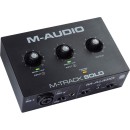
M-Audio M-Track Solo |
VS | |||
|---|---|---|---|---|
| Analog: 2 Inputs / 2 Outputs |
Channels of I/O |
Analog: 2 Inputs / 2 Outputs at 192 kHz |
Analog: 2 Inputs / 2 Outputs at 192 kHz |
Analog: 2 Inputs / 2 Outputs at 192 kHz |
| 48 kHz / 16-Bit | Maximum Sampling Rate | 192 kHz / 24-Bit | 48 kHz / 24-Bit | 192 kHz / 24-Bit |
| 1 Preamp | Number of Microphone Inputs | 1 Preamp | 2 Preamps | 1 |
| 1x Combo XLR-1/4" TRS Balanced Mic/Line Input (Front Panel) 1x 1/4" TRS Balanced/Unbalanced Line/Hi-Z Input (Front Panel) 1x Stereo RCA Coaxial Unbalanced Monitor Output 1x 1/8" / 3.5 mm TRS Unbalanced Headphone Output (Front Panel) |
Analog Audio I/O |
1x Combo XLR-1/4" TRS Balanced Mic/Line Input 1x 1/4" TS Unbalanced Hi-Z Input (Front Panel) 2x 1/4" TRS Balanced Line Output 1x 1/4" TRS Unbalanced Headphone Output (Front Panel) |
2x Combo XLR-1/4" TRS Balanced/Unbalanced Mic/Line/Hi-Z Input (Front Panel) 2x 1/4" TRS Balanced Line Output 1x 1/4" TRS Unbalanced Headphone Output (Front Panel) |
1x XLR 3-Pin Balanced Mic Input 1x 1/4" TS Unbalanced Line/Hi-Z Input (Front Panel) 2x 1/4" TRS Balanced Monitor Output 1x 1/4" TRS Headphone Output (Front Panel) |
| 1x USB-B (Class-Compliant) | Host Connection | 1x USB-C (Class-Compliant) | 1x USB-B (Class-Compliant) | 1x USB-C |
| macOS 10.8 or Later Windows 7 or Later (32-/64-Bit) |
OS Compatibility |
macOS 10.8 or Later Windows 7 or Later |
macOS 10.8 or Later Windows 7 or Later (32-/64-Bit) |
macOS Windows |
| USB Bus Power | Power Requirements | USB Bus Power | USB Bus Power | USB Bus Power, USB Power Adapter (Not Included) |
